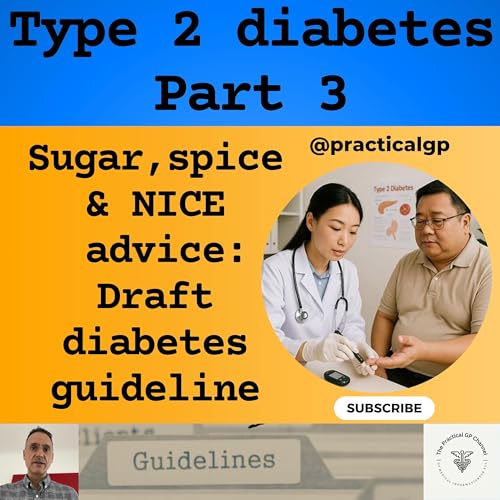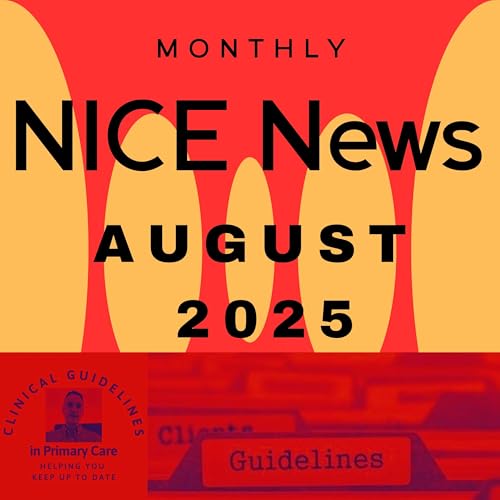The video version of this podcast can be found here: · https://youtu.be/i0L-Nv4bJzsThis episode makes reference to guidelines produced by the "National Institute for Health and Care Excellence" in the UK, also referred to as "NICE". The content on this channel reflects my professional interpretation/summary of the guidance and I am in no way affiliated with, employed by or funded/sponsored by NICE.NICE stands for "National Institute for Health and Care Excellence" and is an independent organization within the UK healthcare system that produces evidence-based guidelines and recommendations to help healthcare professionals deliver the best possible care to patients, particularly within the NHS (National Health Service) by assessing new health technologies and treatments and determining their cost-effectiveness; essentially guiding best practices for patient care across the country.My name is Fernando Florido and I am a General Practitioner in the United Kingdom. In this episode I go through the NICE guideline on Chronic heart failure in adults: diagnosis and management [NG106], last updated in September 2025. Today’s episode focuses on the additional management of heart failure. In previous episodes we covered the initial assessment and diagnosis and the drug management of the different subtypes of heart failure.I am not giving medical advice; this video is intended for health care professionals, it is only my summary and my interpretation of the guidelines and you must use your clinical judgement. Disclaimer:The Video Content on this channel is for educational purposes and not intended to be a substitute for professional medical advice, diagnosis, or treatment. Always seek the advice of your physician or other qualified health provider with any questions you may have regarding a medical condition. Never disregard professional medical advice or delay in seeking it because of something you have read or seen on this YouTube channel. The statements made throughout this video are not to be used or relied on to diagnose, treat, cure or prevent health conditions. In addition, transmission of this Content is not intended to create, and receipt by you does not constitute, a physician-patient relationship with Dr Fernando Florido, his employees, agents, independent contractors, or anyone acting on behalf of Dr Fernando Florido. Intro / outro music: Track: Halfway Through — Broke In Summer [Audio Library Release] Music provided by Audio Library Plus Watch: https://youtu.be/aBGk6aJM3IU Free Download / Stream: https://alplus.io/halfway-through There is a podcast version of this and other videos that you can access here: Primary Care guidelines podcast: · Redcircle: https://redcircle.com/shows/primary-care-guidelines· Spotify: https://open.spotify.com/show/5BmqS0Ol16oQ7Kr1WYzupK· Apple podcasts: https://podcasts.apple.com/gb/podcast/primary-care-guidelines/id1608821148 There is a YouTube version of this and other videos that you can access here: The Practical GP YouTube Channel: https://youtube.com/@practicalgp?si=ecJGF5QCuMLQ6hrk The NICE guideline on Chronic heart failure in adults: diagnosis and management [NG106] can be found here: · https://www.nice.org.uk/guidance/ng106 Additional information on ARNIs can be found here: · https://www.ncbi.nlm.nih.gov/books/NBK507904/#:~:text=Mechanism%20of%20Action,-The%20pathophysiology%20of&text=Valsartan%20is%20an%20angiotensin%20receptor,neprilysin%20will%20accumulate%20angiotensin%20II TranscriptIf you are listening to this podcast on YouTube, for a better experience, switch to the video version. The link is in the top right corner of the video and in the episode description.Hello and welcome! I’m Fernando, a GP in the UK. In today’s episode, we are going to go through the NICE guideline on Chronic heart failure, which was last updated in September 2025.Today’s episode focuses on the additional management of heart failure. If you haven’t already, I recommend that you check the previous episodes where we covered heart failure diagnosis and the drug management of the different subtypes of heart failure.Right, let’s jump into it.And as we have just said, today we’re going to focus on the additional management of heart failure. Now let’s start by looking at how to initiate and monitor medication use.When tailoring treatment, we should use the person’s medical history, frailty status, and prognosis to decide which specific medicine combinations to use and how to introduce them.In primary care, we should seek the advice from a heart failure specialist before starting someone on an angiotensin receptor–neprilysin inhibitor, that is, sacubitril/ valsartan.Before prescribing an ACE inhibitor, ARB, angiotensin receptor-neprilysin inhibitor (ARNI), or mineralocorticoid receptor antagonist, we will measure renal function and electrolytes.Once these drugs have been ...
続きを読む
一部表示
 8 分
8 分 8 分
8 分 7 分
7 分 2025/10/159 分
2025/10/159 分 2025/10/0813 分
2025/10/0813 分 2025/10/0111 分
2025/10/0111 分 2025/09/2412 分
2025/09/2412 分 12 分
12 分
